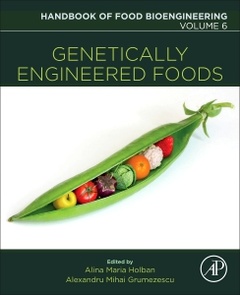Description
Genetically Engineered Foods
Handbook of Food Bioengineering Series
Coordinators: Grumezescu Alexandru Mihai, Holban Alina Maria
Language: English
Subject for Genetically Engineered Foods:
Keywords
l-ribose; abiotic stress; allergy; animal feeding studies; approved crops; awareness; biofortification; biosensors; composition; controversies; cyanobacteria; degenerative diseases; detection; DNA damage; DNA transfer; DNA-based assays; drought; economic concerns; embryo rescue; environment; epigenetic modification; erythritol; feed; food; food additives; food safety; food security; fucose; functional foods; genetic engineering; genetic modified foods; genetic transformation; genetically engineered foods; genetically modified foods; genetically modified microorganisms; genetically modified organisms; genetically modified organisms plants and animals; genetically modified plants; genosensors; GM crops; GMO; GMOs; heat; human health; immunosensors; improvement; intended effects; lactic acid bacteria; malnutrition; mannitol; mannose; medicinal plants; metabolic engineering; microarray; modification methods; mushrooms; next generation sequencing; Nigeria; omics; osmoprotectant; plant breeding; plant genetic modification; potential risks; protective activity; protein-based assays; quality; ready-to-use therapeutic foods; real-time PCR; resistance; risk; risk assessment; safety; safety assessment; salinity; sampling; somaclonal variation; stress-responsive genes; sucrose l-sugars; tagatose; therapeutic foods; toxicology; transcription factors; unintended effects; utilization; validation methods; yeasts
Support: Print on demand
Description
/li>Contents
/li>Biography
/li>Comment
/li>
Genetically Engineered Foods, Volume 6 in the Handbook of Food Bioengineering series, is a solid reference for researchers and professionals needing information on genetically engineered foods in human and animal diets. The volume discusses awareness, benefits vs. disadvantages, regulations and techniques used to obtain, test and detect genetically modified plants and animals. An essential resource offering informed perspectives on the potential implications of genetically engineered foods for humans and society. Written by a team of scientific experts who share the latest advances to help further more evidence-based research and educate scientists, academics and government professionals about the safety of the global food supply.
2. Sugar and sugar alcohol production in genetically modified cyanobacteria
3. Genetically modified plants as sustainable and economic sources for RUTFs
4. Approved genetically engineered foods: types, properties and economic concerns
5. Influence of Feed from Genetically Modified Plants (GMP) on Composition and Quality of Food of Animal Origin
6. Genetically Modified Microorganisms: Harmful or Helpful?
7. Techniques for Production and Quality Assessment of Genetically Modified Foods
8. Awareness and utilization of genetically modified foods in Nigeria
9. Biosensors as advanced device for transgenic plants and food and detection
10. Genetically engineered food crops to abiotic stress tolerance
11. Detection of Prevented DNA Damage by Therapeutic Foods
12. Genetically engineered crops: Opportunities, constraints and food security at a glance of human health, environmental impact and food quality
13. Safety and risk assessment of food from genetically engineered crops and animals: the challenges
14. Identification of Genetically Modified Foods
15. Methods for Plant Genetic Modification
Alina-Maria Holban is a lecturer in Microbiology and Immunology, at the Faculty of Biology, University of Bucharest; and associate researcher at the University Politehnica of Bucharest, Romania. Her primary area of research is the development of bionanomaterials with antimicrobial applications. Dr. Holban has published 75 papers in peer-reviewed journals, 42 conference/symposia proceedings, and has edited more than 21 edited books.
- Provides in-depth coverage of the issues surrounding genetic engineering in foods
- Includes hot topic areas such as nutragenomics and therapeutics to show how genetically engineered foods can promote health and potentially cure disease
- Presents case studies where genetically engineered foods can increase production in Third World countries to promote food security
- Discusses environmental and economic impacts, benefits and risks to help inform decisions




